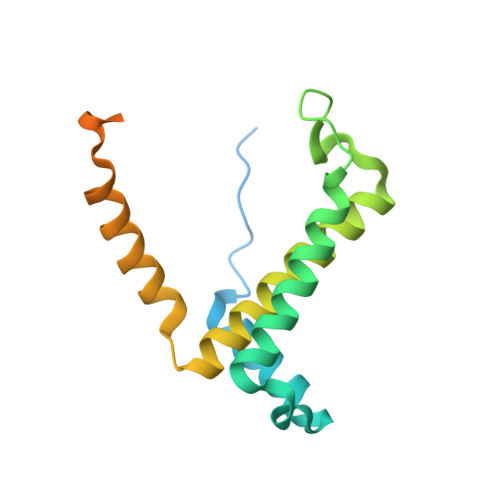The First Structure of an Active Mammalian dCTPase and its Complexes With Substrate Analogs and Products.
Scaletti, E., Claesson, M., Helleday, T., Jemth, A.S., Stenmark, P.(2020) J Mol Biol 432: 1126-1142
- PubMed: 31954130
- DOI: https://doi.org/10.1016/j.jmb.2020.01.005
- Primary Citation of Related Structures:
6SQW, 6SQY, 6SQZ - PubMed Abstract:
Precise regulation of dNTPs within the cellular nucleotide pool is essential for high accuracy of DNA replication and is critical for retaining the genomic integrity. Recently, human dCTPase (deoxycytidine triphosphatase), also known as DCTPP1 (human all-alpha dCTP pyrophosphatase 1), has been revealed to be a key player in the balance of pyrimidine nucleotide concentrations within cells, with DCTPP1 deficiency causing DNA damage and genetic instability in both chromosomal and mitochondrial DNA. DCTPP1 also exhibits an additional "house cleaning" function as it has been shown to be highly active against modified cytidine triphosphates, such as 5-methyl-dCTP, which, if incorrectly incorporated into DNA can introduce undesirable epigenetic marking. To date, structural studies of mammalian dCTPase have been limited to inactive constructs, which do not provide information regarding the catalytic mechanism of this important enzyme. We present here the first structures of an active mammalian dCTPase from M. musculus in complex with the nonhydrolyzable substrate analog dCMPNPP and the products 5-Me-dCMP and dCMP. These structures provide clear insights into substrate binding and catalysis and clearly elucidate why previous structures of mammalian dCTPase were catalytically inactive. The overall structure of M. musculus dCTPase is highly similar to enzymes from the all-alpha NTP phosphohydrolase superfamily. Comparison of M. musculus dCTPase with homologs from a diverse range of mammals, including humans, shows that the residues, which contribute to substrate recognition, are entirely conserved, further supporting the importance of this enzyme in the protection of genomic integrity in mammalian cells.
Organizational Affiliation:
Department of Experimental Medical Science, Lund University, Lund, 221 00, Sweden; Department of Biochemistry and Biophysics, Stockholm University, Stockholm, S-106 91, Sweden.
















